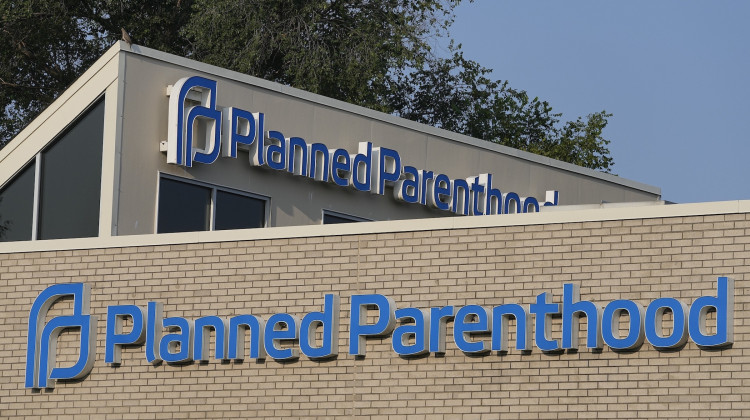
A Planned Parenthood sign is displayed on the outside of a clinic in Indianapolis. On April 3, leaders of the organization said Planned Parenthood is assessing next steps, but hope expanded virtual appointments can help fill some of the gaps caused by the funding freeze.
Darron Cummings / AP PhotoMore than 3,000 people in Indiana could lose access to birth control, cancer screenings, and sexually transmitted disease testing after the Trump administration froze tens of millions of dollars in federal funding from Planned Parenthood affiliates nationwide, including in Indiana.
Although the number of abortions has plummeted since Indiana implemented a near-total abortion ban in 2023, the Trump administration has still sought to target the state’s Planned Parenthood services. The administration is largely coming after Title X funding, a federal grant program to support family planning and preventative health services.
Last year, Indiana received just over $5 million in Title X funding, according to data from the Department of Health and Human Services.
Dr. Tracey Wilkinson, a pediatrician and reproductive health services researcher in Indiana, said targeting Planned Parenthood sends a warning to every Title X clinic in the state, which she often refers uninsured and low-income patients to.
“It feels like anybody could be next,” Wilkinson said. “It's the point of making sure everybody is on notice to let them know that, like their funding could be taken next.”
The Trump administration said the funds are being paused “pending an evaluation of possible violations of their grant terms, including based on federal civil rights laws and the President’s Executive Order 14218, ‘Ending Taxpayer Subsidization of Open Borders,’” which Trump signed on Feb. 19, a spokesperson for the Department of Health and Human Services told TIME. The referenced Executive Order prohibits undocumented immigrants “from obtaining most taxpayer-funded benefits.”
The three Planned Parenthood clinics in Indianapolis don’t receive Title X funding, but the Lafayette location does, according to reporting from Mirror Indy. That could lead to increased demand at clinics in Indianapolis and other parts of the state.
Anti-abortion rights groups, including National Right to Life, have called on the Trump administration to cut federal funding to Planned Parenthood. According to the organization, more than 150 anti-abortion groups signed a letter to Congress March 26 urging lawmakers to take action.
“American taxpayers should not have to underwrite a multi-billion dollar abortion industry,” said Carol Tobias, president of National Right to Life. “Taxpayers certainly don’t want to see their money being used to end the lives of innocent preborn children.”
But the Title X funding being targeted pays for family planning services and cannot be used to pay for abortion.
Rebecca Gibron, CEO of Planned Parenthood Great Northwest, Hawai‘i, Alaska, Indiana, Kentucky, said the move is less about abortion and more about punishing the organization and its patients.
“Their agenda is the same as the anti-abortion groups that support them: punish patients, punish Planned Parenthood, and dictate which patients can get health care and what care they can get,” Gibron wrote in a press release after the funding announcement.
In an interview with WFYI on Thursday, Gibron said that Planned Parenthood is assessing next steps, but hopes expanded virtual appointments can help fill some of the gaps caused by the funding freeze.
But with less funding, there will likely be more people in Indiana seeking care elsewhere, putting strain on other clinics and medical providers, said Dr. Wilkinson, who worries how that will impact preventative care like cancer screenings.
“The clinical systems that are in place don't really have the ability to pick up all that missing care,” she said. “You can't just eliminate one and expect the next day for the current health care system to suddenly be able to support all of that care.”
The funding freeze also comes amidst the wait for a U.S. Supreme Court decision in a case that will decide whether states can remove Planned Parenthood clinics from state Medicaid programs, despite the fact that Medicaid cannot generally be used to pay for abortions.
In 2024, Planned Parenthood health centers in Indiana saw more than 34,000 patient visits. According to the organization, 52% of patients live at or below the federal poverty line, 41% identify as Black, Indigenous, or people of color, and one-third rely on Medicaid.
Liane Hulka, a staffer with the Our Choice Coalition, a pro-abortion political action committee, said the more restrictive policies and funding cuts are curtailing access to services beyond abortion.
“It does feel a little bit like death by 1000 paper cuts,” Hulka said.
Angie Kliztsch, the CEO of Women 4 Change, an Indiana-based political action committee focused on protecting abortion rights, said the patients Planned Parenthood locations aren’t able to take on will have to go somewhere else.
“If Planned Parenthood is not able to absorb and service neighbors in those communities, healthcare systems will be overrun,” Kliztsch said. “The absorption will have to happen elsewhere, or many Hoosiers will not get the health care services that they need.”
Farrah Anderson is an investigative health reporter with WFYI and Side Effects Public Media. You can follow her on X at @farrahsoa or by email at fanderson@wfyi.org.
 DONATE
DONATE







 Support WFYI. We can't do it without you.
Support WFYI. We can't do it without you.